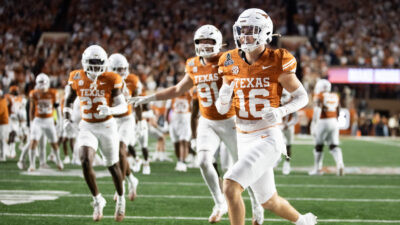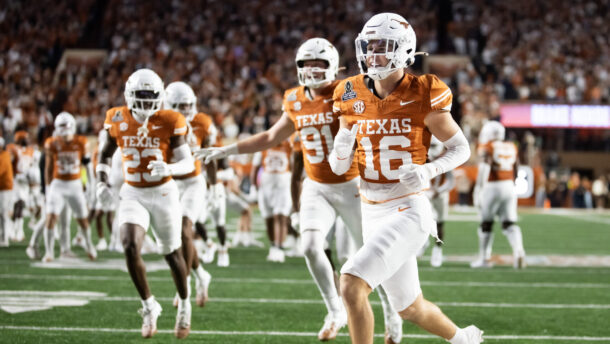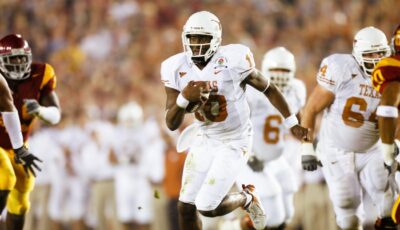Film Study: Auburn most capable of replicating Ohio State’s success
By Murf Baldwin
Published:
No matter how Southeastern Conference-centric you are, you have to admit the masterful job done by Urban Meyer and his Ohio State University football team throughout the regular and postseason.
After a 59-0 thrashing of the University of Wisconsin in the Big 10 Championship Game, with its third-string quarterback, no less, the Buckeyes laid the smack down in a convincing 42-35 victory over perennial SEC favorite, the University of Alabama.
But it was the 42-20 annihilation of the University of Oregon which cemented that Ohio State’s philosophy, execution and personnel was exactly where college football is headed for the foreseeable future.
Think about it; all three of the programs OSU beat on the way to its national title claim were very different in scheme and personnel — which sort of coincides with each team being from a different conference.
Wisconsin is the ultimate, traditional ground-and-pound outfit, led by the top running back in all of football in Melvin Gordon (2,587 yards rushing), and supported by a physical defense (4th-ranked in the country) based out of an odd-numbered front.
Alabama, while more of a passing outfit this season, is known for its balance and its ability to oscillate between even- and odd-front alignments on defense, while Oregon employs a spread-to-run offensive scheme with a speed-based, hybrid “34” defensive attack.
Needless to say OSU ran the gauntlet of schemes and personnel while showing that its brand of football superseded it all: a power spread-based offense with stretch-vertical elements in the passing game accompanied by an even-front defense with the ability to virtually stay in base personnel no matter the opponent.
You can bet your bottom dollar that the Buckeyes won’t be disappearing from the national title landscape as long as Meyer is at the helm.
But if you’re projecting forward to the 2015-16 season, and you’re looking for a team with the ability to replicate the same elements which made OSU a beast this season, you should look no further than Auburn University.
It has the scheme, coaching and personnel to cause a lot of problems on offense, and the personnel additions on defense will undoubtedly take a porous unit, in a football sense, and give it a complete makeover.
Gus Malzahn, Jeremy Johnson And The Crew
By now you’ve all heard the story of OSU redshirt sophomore quarterback Cardale Jones and his rise to prominence behind his close to flawless performance in the postseason when he was thrust into the lineup after a season-ending injury to starter J.T. Barrett in the penultimate game of the Big 10 schedule.
The 6’5″, 250-pound Jones nearly went from being completely off the radar to being a potential early round selection in the NFL draft, all in three games.
His full-grown man frame was supported by just about every characteristic one might find in a No. 1-overall selection in the draft: a cannon-like arm equipped with a piston-quick throwing motion, accuracy throughout the full route-tree and mobility to manufacture first downs in the designed or bolt-the-pocket run game.
To put it simply, Jones is a next-level QB who is capable of strapping an entire program on his back and willing it to victory. And it didn’t hurt that his team was pretty much stacked across the board from offense, defense, special teams and coaching staff.
But what if I told you that he was merely the midwest’s version of Auburn QB Jeremy Johnson who previously displayed the same exact skill set except the starter he was behind stayed healthy for the two years he’s been on campus.
I wholeheartedly believe that if former Tiger great Nick Marshall would’ve been injured prior to the SEC Championship game in 2013, Johnson would’ve stepped in and achieved similar acclaim to that of Jones as the Tigers wouldn’t have missed a beat behind the true freshman.
The 6’5″, 230-pound signal-caller has every bit the arm strength as Jones, and he just may be a tad more accurate in the short-to-intermediate game. And while he isn’t quite the athlete of his predecessor, he’s more than capable of navigating any plays in the Tigers’ vast run game.
But more than likely head coach Gus Malzahn will allow Johnson to deal from the pocket as his ability to get the ball to the Tigers’ inordinate amount of skilled talent supersedes what he may bring with his legs.
Johnson’s ability to spray the ball around the entire route tree opens up the Tiger’s vertical game. By consistently hitting the deep quadrants of the field, Malzahn will push back the attention that is normally paid to a scheme that has been primarily based off the run game.
While the loss of vertical threat Sammie Coates is huge, having the versatile Duke Williams back may be even bigger. Williams is virtually indefensible in the quick game and has shown the ability to separate on vertical routes through pure route-running prowess.
Fellow receiver Ricardo Louis may very well step into the vertical role in Coates’ stead, and I have very little doubt he will excel in said role; Auburn’s air attack is about to go to a whole new level.
Johnson’s precise accuracy is on display here against area coverage. He knows how to manipulate coverage with his eyes and his ball-handling skills are top notch; this is where Jones excelled for the Buckeyes.
To truly replicate the Ohio State formula, one must have access to the deep ball. As we see here, Johnson can darn near go vertical with his eyes closed (which would actually be kind of cool).
While Meyer is arguably the best coach in all of college football, who popularized the spread-based offense in his time as HC of the University of Florida, Malzahn is right on his heels — at least as far as scheming defenses to death.
Both employ a spread-to-run scheme; both can derive plenty of power in the between-the-tackles run game.
For all the press that Jones received from OSU’s run, and rightfully so, it’s running back Ezekiel Elliott who deserves the lion’s share of the offensive praise. His ability to take the souls of defenses with power runs, and combine it with some of the most explosive jaunts you’ll see will go down in college football lore.
While Auburn loses running threats Cameron Artis-Payne, Corey Grant and Marshall, I expect the run game to be as dynamic behind the stylings of junior college transfer Jovon Robinson — who could very well be the newcomer of the year in the conference.
The 5’11”, 225-pound Robinson follows Artis-Payne and former superstar Tre Mason as the hammer in Malzahn’s tool belt. But make no mistake about it; when he gets past the second-level of the defense, it’s curtains.
Robinson reminds me of the college version of former Alabama Crimson Tide star Trent Richardson with his blend of power and short-area agility.
Robinson is about to jump on the radar of NFL scouts during Auburn’s annual spring game with plays like the one below.
His ability to break tackles will fall right in line with his predecessors, and he may be the fastest of them all.
Sophomore back Peyton Barber, 5’11”, 225 pounds, will get plenty of clock behind Robinson, just like Artis-Payne did with Mason. But it will be the electrifying Roc Thomas who will make defensive coordinators queasy thinking about how to stop him in the edge-bending run game.
Offensive coordinator Rhett Lashlee plays the Tom Herndon to Malzahn’s Meyer. The duo does a fantastic job of making sure Auburn dominates in the trenches if it can’t do anything else; this is also synonymous of a Meyer-led offense.
DEFENSE ABLE TO OPERATE FROM BASE
Since I’ve already waxed poetic on the direction of Auburn’s defense behind the stylings of new coordinator Will Muschamp, perhaps the preeminent defensive mind in the business, this section will be brief (click here to read my complete scheme breakdown of the Muschamp hire).
What most stood out to me about Ohio State was its ability to operate within the base structure of its defense. In doing so, it showed the ability to be prepared for just about anything the offense showed — even a hurry-up, no-huddle attack.
This had mostly to do with the presence of versatile linebackers Darron Lee, Joshua Perry and Curtis Grant.
Lee is a budding superstar as he undoubtedly has the ability to cover slot receivers and tight ends, and he can also rush the passer and chase down ball-carriers.
Operating out of an even-front alignment, which, in my opinion, allows for all down linemen to be a factor — especially in a one-gap scheme — is the way to go when you really have your personnel cooking.
But when you have coverage linebackers, such as Perry and Lee, your scheme reaps the benefit of having sound tacklers on the field who also have the length to be effective in area coverage.
Auburn has two of the most underrated LBs in the conference in “Mike” backer Cassanova McKinzy and “Will,” Kris Frost. The 6’3″, 249-pound McKinzy is a thumper who can also play in reverse.
The 6’2″, 234-pound Frost is a run-and-hit backer who can be deployed in a plethora of ways. Muschamp’s scheme, a hybrid “43,” requires versatility from its off-the-ball linebackers, so the coach stepped into a situation better than most think after being relieved of his duties as head coach of the Florida Gators.
And when you factor in highly touted transfer Tray Matthews’ presence at the free safety position, among a host of other talented players in the third level, you truly get a team that is capable of being balanced in all facets of the game.
It’s not that any team needs to replicate what made Ohio State successful, it just doesn’t hurt to have the capability to. Next season should be one to remember for the Tigers of Auburn.
Former linebacker/safety Murf Baldwin specializes in diving deep into the Xs and Os of the game with the goal of educating and entertaining while bringing fans closer to their team.











